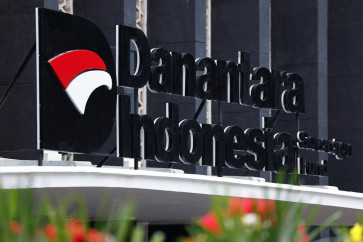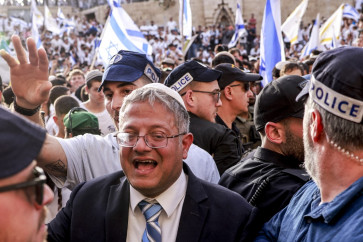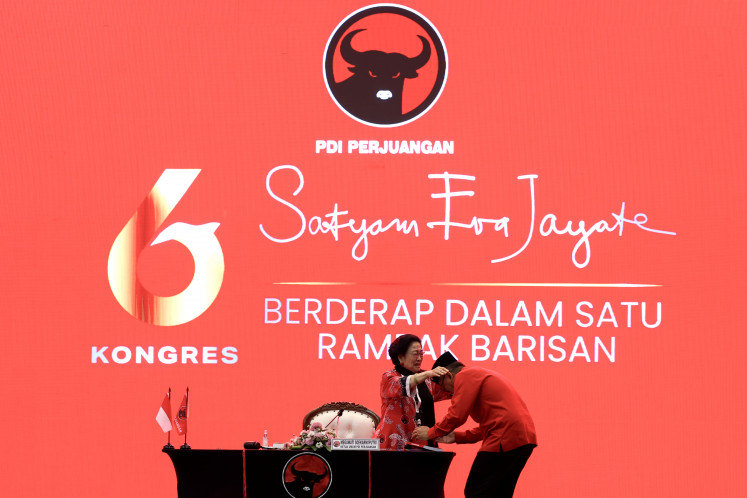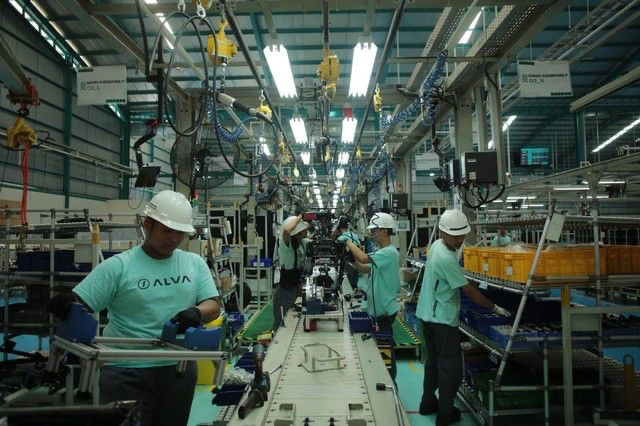Popular Reads
Top Results
Can't find what you're looking for?
View all search resultsPopular Reads
Top Results
Can't find what you're looking for?
View all search resultsContemporary artists and old masters meet in Mayfair
A white-bearded man on a red rock amid a gloomy sky nestled unobtrusively at “Crouching Tigers and Hidden Dragons: the Development of Modern and Contemporary Indonesian Art” exhibit
Change text size
Gift Premium Articles
to Anyone
A
white-bearded man on a red rock amid a gloomy sky nestled unobtrusively at “Crouching Tigers and Hidden Dragons: the Development of Modern and Contemporary Indonesian Art” exhibit.
Maestro: Hermit in a Mountainous Landscape (14.5 cm x 11.8 cm) by Raden Saleh is the highlight of the 24 outstanding works displayed in an exhibition at the ArtSpace Gallery in London’s affluent Mayfair. JP/Ati Kisjanto
But the oil painting by Indonesian master Raden Saleh titled Hermit in a Mountainous Landscape — despite being only 14.5 centimeters by 11.8 centimeters, was the highlight of the 24 outstanding works displayed in the exhibition at the ArtSpace Gallery in London’s affluent Mayfair.
“Raden Saleh painted this interesting work of art in 1838 at the time when he was studying with the reputed Dutch painters Cornelis Kruseman and Andries Schelfhout,” explained Viv Lawes who was co-curator of the exhibition.
Kruseman was known for his portraits and biblical subjects, and Schelfhout was a prominent landscape artist. “We can see in this particular painting how Raden Saleh learned and absorbed the western technique from the romantic period,” she said.
Maria Indria Sari’s Rush Hour dominates another wall of the two-floor gallery. The mixed media work by the young artist from Yogyakarta depicts a woman trying to juggle raising children with dozens of other tasks.
Another prominent display is Astari’s silver-colored bronze sculpture of an Hermès bag with a strand of praying beads and sunglasses dangling out of one side. Stuffed inside are a Koran and The Asian Wall Street Journal, both apparently important life guides and reading material for the bag’s owner.
The exhibition was organized by One:East Asia, a Singapore-based art management company. It comprises Indonesian artists’ works from the late 19th-century Dutch colonial romantic era through the revolution, the Bandung and Yogyakarta schools’ influence, to modern Indonesian art. An eclectic array of interesting art lovers attended the opening.
The exhibition brought together a palette of different nuances of Indonesian paintings. Hendra Gunawan’s Street Performer; S. Sudjojono, the founding father of modern art criticizing the Soeharto regime in his 1977 painting with the presidential palace in the distance in Tell Me Why; Raden Roedyat Martadiradja’s Nude, which combines cubism and abstraction; and Dede Eri Supria’s Street Sweepers, representing chaotic urban growth.
The resistance theme continues in Heri Dono’s wayang puppets criticizing the Indonesian government in his 2005 Fermentation of the Mind, while Yunizar’s Composition of Empty Bottles represents freedom, but that fear is still deep in the hearts of Indonesians because of lingering political uncertainty. Tommy Wondra’s No. 14 work of Muslim calligraphy and the artist-singer Soni Irawan’s Pose Together prove that cities become faceless and works of art can belong to anyone.
Why exhibit Indonesian artwork in London and why now, in these uncertain economic times? Daniel Komala, chairman of One:East Asia and the exhibition’s other curator explained. “My first entrance to the European market was back in 2007 in Amsterdam,” he said. “But London has always been on my mind. It is the capital city of art in Europe. One needs to take on London if one wants to make a real impact in Europe.”
Contemporary: Astari’s Read, a silver-colored bronze sculpture of a Hermes bag with a strand of praying beads and sunglasses dangling out of one side and stuffed inside are a Koran and The Asian Wall Street Journal, is also a prominent display.JP/Ati Kisjanto
He continued: “In art, we are all parts of a big jigsaw puzzle. Try to get to know Indonesia a bit more, its people and culture. It’s a melting pot of East and Western cultures and the art reflects this clearly. Indonesia has historical connections with England. Once people can sense the link, the art becomes a lot more meaningful.”
Charles Humfrey, British ambassador to Indonesia from 2004 to 2008, said at the opening, “Indonesia is understated, too little known in England. Not many people in England know about Indonesia, let alone its art. We forget that it has been as far back as Francis Drake’s time that Indonesia has fascinated England.”
Komala said after a short presentation on Indonesian art that he hoped people in the audience would have a better understanding of the country’s rich culture, and as a result the art would start to make more sense. Lawes added, “Art also has to be exhibited and seen by as many people as possible; the quality of the act of ‘seeing’ is down to the exhibition to tell a story. I hope that the chapter headings of that story have been successfully sketched out in this small but carefully chosen show.”
It seemed to work, at least for Peter Diepeveen, a consultant who was impressed with the talk that connected with him through his Dutch roots to Dutch painter Willem Gerard Hofker, who found his “Tahiti” in Bali after World War II. Gabriel, a scientist and a painter, thought Hofker’s oil and conte crayon drawing on paper of Ni Kenjoen was extraordinary. “Using blue on a skin color is unnatural, yet it came out outstandingly beautifully. Her pose is also ‘un-Asian’, which makes the painting more exotic.” Hofker’s drawing and etching of the young Balinese girl, bare-chested and leaning on her right hand, attracted many eyes that evening.
And Jung Chang, the author of the international best-selling Wild Swans told The Jakarta Post that she would like to have an Indonesian work of art in her house.
In his talk, Komala highlighted Indonesia’s artistically rich diversity. “Indonesia’s contemporary art started with Sukarno, who dared to be different with his collections,” said Komala. Sukarno, Indonesia’s first president, was a renowned orator and a legendary womanizer, as well as an avid art lover.
Komala was on the team that valued the art at the Indonesian National Palace during the presidency of Sukarno’s eldest daughter, Megawati Soekarnoputri. Komala thinks that the palace’s collections are probably the most valuable in Southeast Asia, even though most of the works are nudes.
As for whether art is for the eye or investment, Komala said, “You would know which art to choose or should belong to you. It’s like a song with a familiar tune that plays in your head because you feel connected to it and automatically it will keep on appearing subconsciously.”
“Art investment is a long-term investment,” he said. “Indonesian art is undervalued now. One has to be a well-informed buyer. There’s no shortcuts. Hence insight, connections and expertise are the most important ingredients. And yes, we have secured some sales and hopefully more to come in the coming weeks.”
The exhibition runs until Nov. 20
ArtSpace Gallery
18 Maddox Street
Mayfair, London











